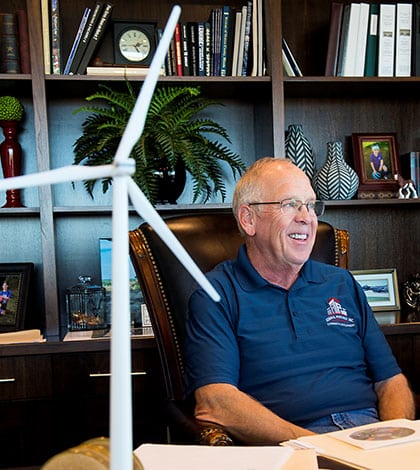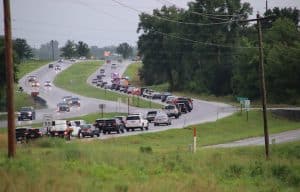IDNR weighs in on wind farm project

Local developer Joe Koppeis discusses his proposed wind farm project with the Republic-Times on Monday. (Alan Dooley photo)
The Illinois Department of Natural Resources earlier this month released a report on the impact a proposed wind farm in rural Monroe County would have on natural resources.
The report is one of the early steps local developer Joe Koppeis and his team must take to submit an application for the wind farm. They have not yet submitted this application to the county.
Koppeis discussed the wind farm, which would be located near the bluffs south of Valmeyer, with the Monroe County Board at an August meeting attended by many local residents.
The report says the wind farm, which will have 50 turbines spread across about 15,000 acres and 15 miles, could affect 79 natural resources including animals, ground water and caves.
Given the impact on the environment, the IDNR gave 19 recommendations related to the project.
The department stressed, however, that its report had a narrow scope and specific role.
“The department’s role in the consultation process is to address potential adverse effects to the natural areas and state-listed endangered and to fish and wildlife habitat generally,” the department wrote.
IDNR also said the project may have “benefits unrelated to natural resources, but that is outside the scope of the consultation process.”
The department compiled the report based on data in the Illinois Natural Heritage Database at the request of Koppeis’s contractor, SCI, Inc.
Koppeis said he did not find the report surprising or troubling.
“It’s exactly what we expected,” he said. “The area that we’re talking about is a huge parcel of ground. There are a lot of areas within that acreage that we need to stay away from. When we had the public meeting at the courthouse, I said we would be staying away from those areas and we will.”
The IDNR recommendations vary in focus.
The first two deal with the ground on which the proposed wind farm would be built.
The first recommendation is that the county consider building the wind farm in another area that is not over karst geology. The second says the county should prohibit the use of geophysical exploration methods likely to damage or penetrate voids beneath the ground.
“The risks karst geology poses to wind turbines can be overcome by several technological means, but the same cannot be said of the risks wind turbines pose to karst geology, particularly where karst features are of unique importance,” the report states.
Given the size of the proposed turbines, which will be the heaviest in the country, they would be more susceptible to causing the ground beneath them to collapse if they are under a void.
The effects of the vibrations caused by these turbines are unknown, but they gave the IDNR cause for concern because they could do anything from stirring up cave sediments to opening new sinkholes.
“Points in the bedrock nine miles or more from the project boundary may receive vibrations from the array, affecting a much larger area than the wind farm itself,” the report states.
Koppeis said the engineers on the project will be able to build foundations that do not vibrate and said he plans to put the turbines on farmland leased from its owners.
He also showed the Republic-Times a map showing all the areas where it would be OK to build a turbine. There is a good amount of land on those maps that would work, although Koppeis said he was flexible if he had to decrease the total number of turbines for the wind farm.
Six more recommendations deal with the county requiring developers to receive authorizations or permits to take animals like the Illinois cave amphipod, Indiana bat and timber rattlesnake.
To take an animal means to “harm, hunt, shoot, pursue, lure, wound, kill, destroy, harass, gig, spare, ensnare, trap, capture, collect, or to attempt to engage in such conduct.”
These are necessary because the IDNR deems it likely to unavoidable that some creatures will be taken as a result of the construction or operation of the wind farm.
The impacts on the various species range from “moderate” in the case of bald eagles to threatening the Illinois cave amphipod with extinction.
Related to those issues, the department provided the county with five suggestions that it require the developer to conduct studies before or after the wind farm begins operation to measure the impact on animals or seismic conditions.
Koppeis said this whole process is about learning.
“It’s just a learning process,” he said. “I think that’s where we are on the wind farm. We’re learning and hopefully everyone else will learn with us.”
To specifically deal with the impact the turbines could have on birds and bats, the IDNR also gave two recommendations that the county require turbine speed to be curtailed or immobilized in certain conditions, such as time of day or during migration season.
The final four recommendations are ones the IDNR typically gives to wind farm projects, advising the turbines be located a certain distance away from sites like nature preserve or land and water reserves.
In the case of at least those latter areas, the department was skeptical of their efficacy.
“Although the department believes this distance may be inadequate to protect these areas from the adverse effects of turbines of the size contemplated for this proposal,” it wrote.
Koppeis said he wants some of the revenue from the project to give back to conservation areas.
Moving forward, Koppeis said he and his team will work with the IDNR to fine tune the locations of the turbines and allay any other concerns. He said he wants the project completed in 2020.
After all the necessary information is complied, Koppeis and his team plan to submit an application to the county.
If that is filed, the county has the discretion to adopt, modify or reject the recommendations, unless the actions are certain to take threatened or endangered animals. The county must provide the IDNR with a written response to the recommendations, if it gets to that point.
Koppeis said he still believes in the project, given the wind measurements he has taken, the proximity to the power transmission lines and, primarily, the tax dollars that would go to local school districts like Valmeyer’s.
“I still think that’s the right thing,” Koppeis said. “I still think it’s good for our region and hope we can get it done. I think it’s going to be good for the environment, good for the community and good for jobs.”
To view the full report, visit monroecountyil.gov/departments/zoning-and-building and click on “IDNR Wind Tower Consultation.”






